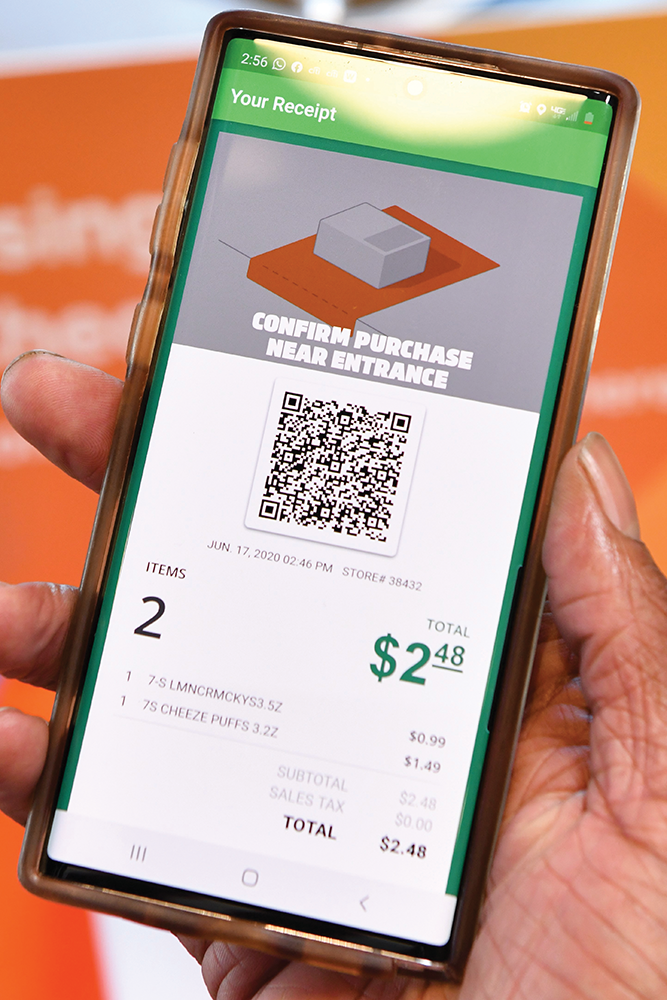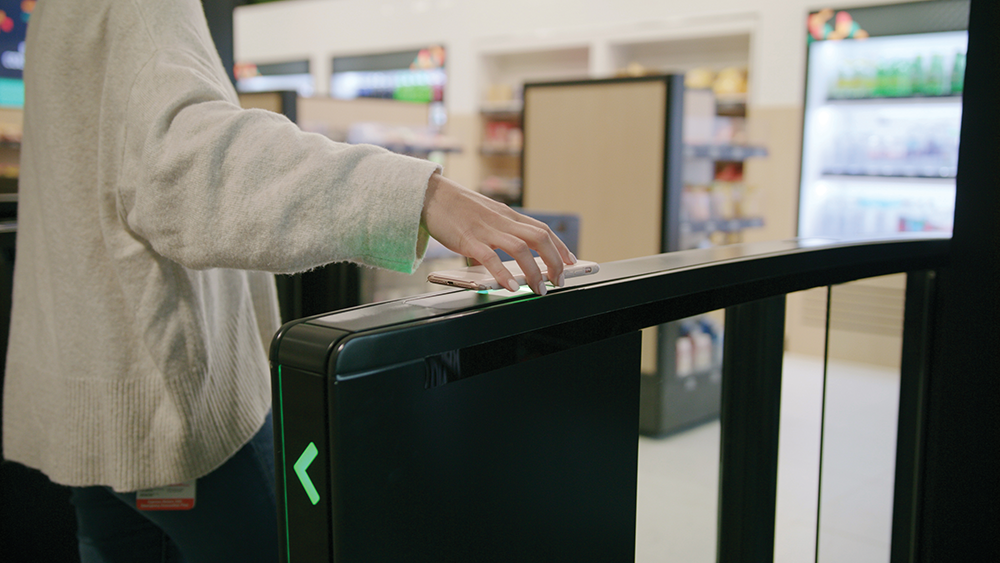Call it bad timing, a confusing user experience, poor execution—or all of the above. Quick-response (QR) codes have struggled to gain traction in retail in the United States. But the evolution of smartphone tech, combined with the rise of loyalty programs and the pandemic’s push toward contactless commerce, have finally given QR codes a chance to prove their worth.
Perhaps the biggest early stumbling block for QR codes was the clunky user experience. “If you just look at the core of mobile technology of your phone, four years ago you had to go get a QR code reader app to read them,” said Gray Taylor, executive director of Conexxus. Now newer models of the Apple iPhone and Android smartphones have QR code readers built into their cameras, making scanning simple and intuitive.
The tech also is more accessible to retailers, with most point-of-sale systems built to a standard that is now capable of reading a QR code, said Taylor. “So that fundamental change tossed the economics back in favor of QR codes.”
Early QR code applications also were troubled by “massively bad execution” by marketers, said Jimmy Matorin, founder of consultancy Smarketing in Cannes, France. For example, an airline’s magazine featured QR codes—which became useless once the airplane took off. A major coffee chain placed a QR code on a sign with no messaging—and after scanning, users found the promotion was over. “I don’t think [marketers] had the right calls to action, and I don’t think they had the right content waiting for you when you scan,” said Matorin.
As QR code technology has improved, its applications in retail have grown more sophisticated and revealed the tremendous capabilities of that small, inscrutable box—from contactless shopping to personalized, simplified identification.
Check It Out
QR codes are serving as a keystone in retailers’ ability to deliver a frictionless shopping experience. 7-Eleven is leveraging QR codes in its contactless Mobile Checkout tool. At the store, customers open the 7-Eleven app and log into the 7Rewards loyalty program. Then, they use the tool to scan barcodes on their purchases to add to their basket and earn points and discounts. Customers can pay with a debit or credit card, or Apple Pay or Google Pay. After the payment is authorized, the user scans a QR code on a confirmation screen.
“The checkout process utilizes unique, one-time-use only QR codes for customers to confirm their purchases on their way out of the store, providing an assured, worry-free and convenient shopping experience for the customers, while enabling a seamless verification to the stores of the purchase,” said Sajjad Khan, senior director of product management, 7-Eleven Inc., Irving, Texas. Mobile Checkout is available at select locations in Dallas; Manhattan and Long Island, New York; and Utah.
The Mobile Checkout tool has the added benefit of increasing customer engagement with 7-Eleven’s app and loyalty program. “QR codes have proven to be an incredibly useful tool for helping customers discover our 7-Eleven app and learn more about specific products and offers,” said Khan.
The contactless nature of the QR code interaction is a selling point during the pandemic.
7-Eleven also is tapping QR codes in its pilot of a fully self-serve cashierless store at its 700-square-foot Store Support Center in Irving, Texas. Users download an app, check in at and enter the store, and then leave once done shopping. “QR codes serve as a unique identifier for each customer, allowing them to check in when entering the pilot store and experience automated shopping,” said Khan.
Loyalty Connection
Casey’s is using QR codes to drive engagement with its loyalty program—and cut down on contact points. In January, the retailer launched its Casey’s Rewards program. As part of the rollout, Casey’s placed signage at the fuel island explaining how to interact with the Casey’s Rewards program, along with a callout directing customers to sign up with a QR code.
“When they point their camera at that QR code, we’ve got some technology behind that that will interpret what device the guest is coming from—an Android or an iPhone—and then it will seamlessly route them out to the app store for their device and drops them right into the details page for our mobile app,” said Mike Templeton, director of digital marketing for Ankeny, Iowa-based Casey’s. “That’s been a huge win for us as people are on their device already at the pump; they’re interested; they want to engage.”
Casey’s Rewards members can use their personalized QR code in the Casey’s app as a shortcut to connect a transaction to their loyalty account. So instead of punching in a phone number at the PIN pad on the counter, members just hold up their device and the employee scans the QR code.
The contactless nature of the interaction is another selling point during the pandemic. “It’s one less thing I have to touch that I’m not familiar with,” said Templeton.
ExxonMobil and Shell are using QR codes to enable contactless payment at the pump through their new partnership with Google’s GPS navigation app Waze. In the Waze app, users get directed to nearby Exxon, Mobil and Shell branded sites. Once they pull into a location, the app prompts them to pay and earn rewards through the Exxon Mobil Rewards+ or Shell app. Customers enter their pump number or scan a QR code at the dispenser that prompts the app to coordinate the transaction.

 7-Eleven’s Mobile Checkout tool allows customers at select stores to scan barcodes to ring up purchases and pay via app, then show a QR code as their proof of purchase. 7-Eleven uses QR codes as a unique identifier for customers at its cashierless test store in Irving, Texas.
7-Eleven’s Mobile Checkout tool allows customers at select stores to scan barcodes to ring up purchases and pay via app, then show a QR code as their proof of purchase. 7-Eleven uses QR codes as a unique identifier for customers at its cashierless test store in Irving, Texas.
ExxonMobil has been using QR codes at its branded sites since its app launched in 2014. In the Waze application, the tech provides a contactless option to customers who want to minimize how much data they share.
“Our most seamless experience is when consumers using or sharing location data can skip this step and pay for gas from inside the comfort of their vehicle,” said Eric Carmichael, Americas fuels marketing manager for Houston-based ExxonMobil. “That said, it is important to offer the option for those who are more comfortable with QR codes rather than sharing location data.”
Getting Personal
In July, Coca-Cola introduced the capability for a consumer to operate its Coca-Cola Freestyle machine from a smartphone. The user scans a QR code at the machine, which transfers the machine interface to their smartphone. “You then select from the full menu of brands and flavors—and pour,” said Michael Connor, chief architect for Coca-Cola Freestyle, in a press release announcing the new feature. “The idea is to be safe, seamless and fun.” The software is slated to be uploaded to all Coca-Cola Freestyle dispensers before the year’s end.
Taylor with Conexxus says Coca-Cola’s move demonstrates the new waterline for QR code applications. “That’s conveyance of identity: my mix, my blend. It’s conveyance of value,” he said. “What retailers tend to do is … conveyance of getting you to a website so you don’t have to type in ‘www whatever.’”
QR codes can no longer have a one-note payoff. Instead, they need to create a shortcut that makes the experience easier, seamless and more secure for the user. Templeton points to the adoption of personalized QR codes by payment companies such as Venmo. Before, a Venmo user had to search for the right person’s account to send or receive money. With personalized QR codes, Venmo users simply scan and transact. “The expectations for the experience have risen,” said Templeton.
QR codes also can give consumers greater control over their identity. As part of the age verification initiative, Conexxus and NACS are developing standards to create a personalized QR code for consumers to buy age-restricted products such as cigarettes and beer, instead of using a driver’s license. The QR code can be conveyed from a cellphone to the retailer’s POS for age verification. (For more about the age verification initiative, read the Crack the Code coverage in this issue.)
“We have taken all of your personally identifiable information out of the mix,” said Taylor. “So QR codes are a great way to cheaply convey a synthetic attribute of your identity in a trusted service provider environment.” The program should go into pilot by year’s end and launch in 2021. Through the age verification effort, NACS and Conexxus are striving to be “the tip of the spear” for secure, synthetic identities.
“The consumer deserves to have all of their identity tokenized, and they deserve that data minimization as part of the use case of that identity,” said Taylor. “They need to be in total control of it. And it should be in a free container that is standardly available to any consumer who wants it.”
Taylor predicts that the trend toward tokenization will grow over the next decade. “And the best way to convey that outside of a radio frequency communication is to use a QR code,” he said. “So QR codes are only going to get more popular.”